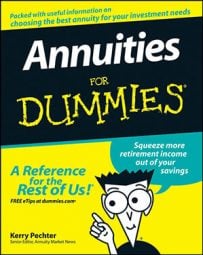Would you buy an insurance policy today that would cost you about one-fifth of your savings and pay you a guaranteed lifetime income starting at age 80 or so? If you died before age 80, you'd lose your original premium, but if you lived to age 85 or 90, you'd eventually get back much more than you paid up front.
What is described above is an advanced life deferred annuity, or ALDA. On the surface, this might seem like a bad investment, but it's not really an investment at all. Instead, it's insurance against the risk that you'll live longer than you can afford to. Indeed, actuaries and economists call it longevity insurance.
You've probably never heard of ALDAs. So far, only a few insurance companies sell them. But they're worth considering. In addition to removing your fear of running out of money in retirement, they can make retirement planning easier. They can even make spending money in retirement more fun.
How ALDAs work
In an unadulterated ALDA, you give a portion of your retirement savings — 10 to 25 percent — to an insurance company in return for a guaranteed specific monthly income starting at whatever age you choose — 75, 80, or 85 years.
The earlier you pay for the contract, the better, because your premium will have time to earn in the carrier's coffers and buy you more income later. The later you start receiving payments, the more income you'll get each year, simply because you'll collect your benefits for fewer years.
How ALDAs save you money
What ALDAs lack in cash value, they make up for in insurance value. You can guarantee yourself much more income at age 80 or 85 by buying an ALDA than by self-insuring — that is, by under-spending or setting up a rainy-day fund that you can use "just in case" you live longer than you expect.
Here's a comparison of the two strategies:
- With self-insuring, you might set aside your own personal old age fund at age 60.
For instance, if you put $23,700 in reserve at age 60 and invested it in bonds paying 5 percent per year, you'd have about $80,000 by age 85. You could then buy an annuity that paid $1,000 a month for life. If you died before age 85, your heirs would get the entire reserve.
- With an ALDA, you'd pay only about $16,000 (according to one company's quote) at age 60 for a lifetime income of $1,000 starting at age 85. That's a savings of $7,700.
Why is the ALDA cheaper than self-insuring? For the same reason that homeowner's insurance is cheaper than paying for damage to your home: because most homeowners never file a claim, and their premiums are used to reimburse the few who do. Similarly, the premiums of the ALDA owners who don't reach age 85 — and never file a "claim" — go to pay for the ones who do.

